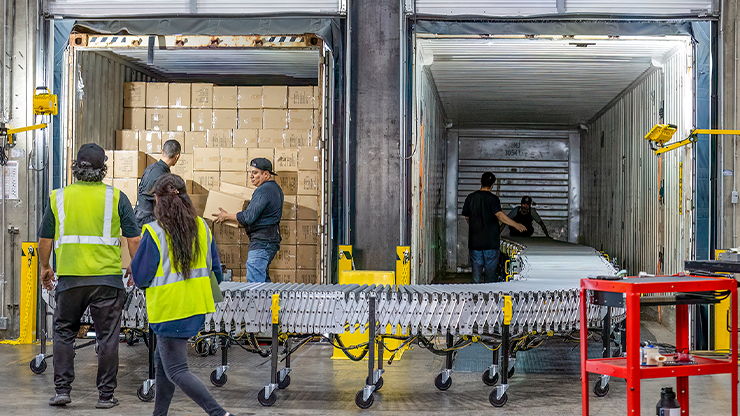How J.B. Hunt’s Transloading Service Moves Freight Fast

Congestion at the ports, and the resulting shipping delays, have been a frequent problem in the last few years. This congestion isn’t only the result of ships waiting at sea to dock, but also in how the freight moves off the ships and onto domestic transportation with intermodal or highway services. There are often similar delays at the border between the United States and Mexico.
To better serve our customers, J.B. Hunt has been hard at work finding ways to address these issues, including opening transload facilities that connect shippers to ports of entry from coast to coast. These facilities help speed up the movement of freight once it’s off the boat or at the border.
The facilities provide solutions for customers who want to move freight more efficiently. Let’s look at the seven locations we operate from:
- Jersey City, New Jersey – Our original facility opened in November 2021 and services shippers who are entering busy East Coast waterways.
- J.B. Hunt’s transload facility in Southern California features a 91,000-square-foot warehouse and a parking lot that is just shy of eight acres—that’s enough to fit up to 300 containers. The facility opened in August 2022.
- The Laredo, Texas, operation services freight crossing the border between the U.S. and Mexico. This location provides a direct opportunity for customers to grow their nearshoring operations, while continuing to support inbound and outbound cross-border traffic.
- The Tacoma, Washington-based facility services freight upon arrival from Seattle and Tacoma ports and helps keep freight moving instead of getting stalled at the port.
- We’ve added transload services in places like Savannah, Georgia; Norfolk, Virginia; and Houston, Texas to continue providing more options and solutions for customers looking to move their freight faster and better.
How Transloading Benefits Customers
It's important to know how the process of getting your shipment from the port to its destination works, and how it impacts your supply chain and your bottom line. An effective port drayage and transloading system can help move freight faster overall, add efficiency to your supply chain and help you manage costs.
This blog will walk you through the life cycle of a load that goes through our Southern California transloading facility, giving you an inside look at J.B. Hunt’s transloading process and how it can benefit your business.
What is Port Drayage?
You’ve booked a shipment, and the vessel carrying your freight has just docked at the California port. Once the container is off the vessel and has cleared all customs obligations, the drayage process begins.
Your freight is loaded onto marine chassis and then taken to J.B. Hunt’s Southern California transloading facility where the transloading process begins. By leveraging J.B. Hunt’s infrastructure, inefficiencies during port drayage can be reduced. Often, the drayage process is split between disconnected providers, slowing the process down. When you use J.B. Hunt’s transloading service, you gain access to teams that can handle the entire drayage and transloading process, providing you with a swift, seamless service that gets your shipment where it needs to go quicker.
What is Transloading?
Ocean import cargo is typically shipped in 20- or 40-foot containers. During transloading, your freight is taken out of the ocean containers and placed into 53-foot containers/trailers by J.B. Hunt’s dedicated transloading team.
The final step of transloading is loading the freight onto its final mode of transportation. With J.B. Hunt’s size, scale and density, not only can we move freight from the port to the transloading facility quickly, but we also have the capacity to get your shipment where it needs to go once it arrives. From our Southern California facility, your shipment can get onto the road or rail fast. The facility is one mile away from highway access and four miles from rail access.
How J.B. Hunt’s Transloading Facilities Create Value in Your Supply Chain
The example above walked you through the process of a shipment going through our Southern California transloading facility. No matter which of the transload facilities you use, you’ll get the same benefits, including:
Seamless service. The location and size of our transloading facilities, combined with J.B. Hunt’s infrastructure, allows us to provide our customers with a seamless port, transload and domestic outbound move.
Unparalleled customer service. Our facilities leverage J.B. Hunt people and equipment, meaning our customers can expect to receive our best-in-class customer service during every step of the port drayage and transloading process.
Faster turn-around time. By offering seamless service, J.B. Hunt is reducing inefficiencies in the supply chain that delay shipping, like shuffling cargo between multiple providers. This means that freight goes from the port to its destination quicker, helping customers lower inventory, which lowers inventory carrying costs.
Reduced costs. By reducing dwell time of the containers at the ports, our customers can save on demurrage charges and per diem costs. Shorter wait times mean lower costs. Additionally, the transload process provides an opportunity to consolidate multiple ocean containers into 53-foot equipment. This reduces the need for inefficient moves and reduces costs.
Building a Better Supply Chain
For over 60 years, J.B. Hunt has made investments in our infrastructure, technology and capacity to provide the best possible service for our customers. J.B. Hunt’s transloading facilities are just one of the supply chain solutions we offer to better serve our customers and are an important step on our way to creating the most efficient transportation network in North America.
Ready to see how J.B. Hunt can help you move freight from the port to where you need it faster? Contact a J.B. Hunt representative today or email FirstMile@jbhunt.com!

